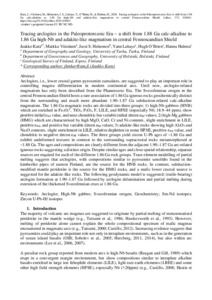Tracing arclogites in the Paleoproterozoic Era - A shift from 1.88 Ga calc-alkaline to 1.86 Ga high-Nb and adakite-like magmatism in central Fennoscandian Shield
Kara Jaakko; Väisänen Markku; Heinonen Jussi S.; Lahaye Yann; O'Brien Hugh; Huhma Hannu
https://urn.fi/URN:NBN:fi-fe2021042826671
Tiivistelmä
Arclogites, i.e., lower crustal gamet-pyroxenite cumulates, are suggested to play an important role in controlling magma differentiation in modem continental arcs. Until now, arclogite-related magmatism has only been described from the Phanerozoic Era. The Svecofennian orogen in the central Fennoscandian Shield hosts a rare association of 1.86 Ga igneous rocks geochemically distinct from the surrounding and much more abundant 1.90-1.87 Ga subduction-related talc-alkaline magmatism. The 1.86 Ga magmatic rocks are divided into three groups: 1) high-Nb gabbros (HNB) which are enriched in Fe2O3T, TiO2, P2O5, F. LILE, and HFSE (especially Nb: 18.9-44 ppm), show positive initial εNd value, and near-chondritic but variable initial zircon εHf values; 2) high-Mg gabbros (HMG) which are characterised by high MgO, CaO, Cr and Ni contents, slight enrichment in LILE, positive εHf, and positive but variable zircon εHf values; 3) adakite-like rocks showing high Al2O3 and Na2O contents, slight enrichment in LILE, relative depletion in some HFSE, positive CNd value, and chondritic to negative zircon εNd values. The three groups yield zircon U-Pb ages of similar to 1.86 Ga and exhibit undeformed textures in contrast to the surrounding supracrustal rocks metamorphosed at similar to 1.88 Ga. The ages and compositions are dearly different from the adjacent 1.90-1.87 Ga arc-related igneous rocks suggesting a distinct origin. Despite similar ages and close spatial relationship, separate sources are required for each of the different 1.86 Ga rock groups. Trace element modelling of partial melting suggests that arclogites, with compositions similar to pyroxenite xenoliths found in the kimberlite pipes of eastern Finland, are the source for the HNB rocks. In contrast, subduction-modified mantle peridotite is the source for the HMG rocks, and a mafic lower crustal source is suggested for the adakite-like rocks. The following geodynamic model is suggested: (rutile-bearing) arclogite formation at 1.90-1.87 Ga followed by arclogite delamination and partial melting during extension of the thickened Svecofennian crust at 1.86 Ga.
Kokoelmat
- Rinnakkaistallenteet [27093]
